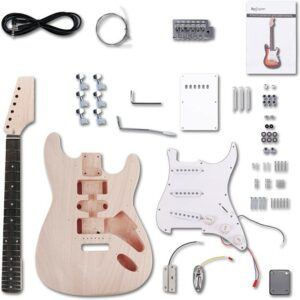DIY electric guitar kits have grabbed the attention of music enthusiasts and hobbyists alike. These kits offer an exciting blend of creativity and learning. Instead of just buying a pre-made guitar, you actually build one yourself, tweaking it to match your personal style and playing needs.
Cost is a major player here. With DIY kits, you’re often spending a fraction of what you would on a custom guitar. It’s not just about saving money, though – the experience itself holds immense value. It’s a hands-on project that teaches you about the instrument’s anatomy and how it works.
Most kits come pretty stocked with necessary components like the neck, body, pickups, and hardware, all ready to be assembled. You don’t have to be a seasoned pro to get started, although a bit of patience and willingness to learn can definitely help.

These kits are the starting point; you can go with what is included, or expand them for true customization. You can finish the body however you like, swap out the pickups for different sound profiles, or change the hardware to suit your preference. The result is a one-of-a-kind instrument that’s truly your own.
You don’t have to spend a ton of money on your initial kit. Various budget-friendly brands stand out, particularly on a platform like Amazon. Each offers features that can appeal to different builders, whether you’re a beginner looking to dip your toes into the guitar-building world or a seasoned player wanting to try something new.
In the following sections, we’ll explore these brands more deeply and provide insights into consumer experiences. Whether you prioritize ease of assembly, sound quality, or aesthetic appeal, there’s a kit out there that’s just right for your needs.
Exploring Budget-Friendly Brands: A Comprehensive Overview
A variety of budget-friendly guitar kit brands flourish on Amazon, catering to DIY enthusiasts of all skill levels. Each brand brings something a bit different to the table.
When shopping for a kit, keep an eye out for the craftsmanship of the body and neck, the quality of the hardware, and how clearly the assembly instructions are laid out. These factors significantly impact not just the building process, but the performance of your finished guitar as well.
Brand reputation is important when picking a guitar kit. A reliable brand ensures you’ll have the support and resources necessary as you embark on your guitar-building journey. Some of these names may be familiar, but many will not. And, in this market, they can change frequently.
Consumer reviews on Amazon serve as a goldmine of information. They provide authentic insights into what you can expect from the kits beyond the product description. Reviews can point out recurring issues, highlight surprising features, and assist in setting realistic expectations.
The following sections will guide you through these elements, focusing on what others have found most valuable in each brand. This approach can help ensure your first (or next) DIY guitar project is both enjoyable and rewarding.
Top Budget-Friendly Brands to Consider on Amazon
Leo Jaymz takes the spotlight for beginners, offering a variety of kits that balance affordability with decent quality. Many users praise its straightforward instructions and the flexibility it provides in terms of customization options. I have personally built a few Leo Jaymz kits and can recommend them.
BexGears stands out for its durability. Reviews often highlight the solid construction of their guitar kits, making them a favorite for those wanting a robust instrument that can withstand regular play once assembled. Most BexGears kits feature an okoume body, a hardwood similar to mahogany.
Fistrock is an up-and-coming brand with a great lineup of solid entry-level DIY kits. They range from the standard Strat, Tele, and P-bass to more unique designs that will catch your eye. Fistrock has a few double-neck DIY electric guitar kits for you to try. Product quality is outstanding and Fistrock customer service is very responsive.
Fesley is a lesser-known brand but a definite go-to for anyone seeking unique designs. Their kits are often noted for incorporating a bit of flair and innovation, appealing to builders who enjoy working with something a little out of the ordinary. The Fesley LP-style kit is highly recommended.
ZEFF impresses with its sleek aesthetics. They have a good selection of bass and electric guitar options. Reviewers frequently mention the high-quality that these kits offer, ensuring your guitar will look as good as it sounds.
Ktaxon has earned a reputation for excellent customer support. This brand is particularly recommended for those who value easy access to help and guidance during their build, with many users appreciating their responsive service. Ktaxon also offers a line of low-priced finished guitars.
Hengyee has been around for a while offering a basic line of DIY kits that strike an admirable balance between visual appeal and functionality. Their kits are recommended for beginners who want a decent-looking guitar that doesn’t compromise on functionality, making it a practical but stylish choice.
DBL is a new entry often highlighted for its classic design elements and attention to detail. Users who prefer a traditional aesthetic with solid performance are drawn to DBL’s range. Check this one out for a pretty broad line of economical kits.
Gleaning Insights from Reviews: A Closer Look at User Experiences
Navigating through the reviews can provide a wealth of firsthand experiences. Users who have tackled various brands share both triumphs and challenges, painting a full picture of what you might face. A recurring theme in reviews is the exuberance of assembling your first guitar. Many highlight the sense of pride when the final bolt is tightened, and the first strum reverberates from a guitar built by their own hands.
Tips from seasoned builders who frequent forums and review sections often emphasize the importance of carefully reading the manual before diving into assembly. This saves time and frustration down the road. While most brands come with well-crafted manuals, some users find online resources and videos from fellow builders invaluable, especially when tackling trickier parts like wiring the electronics or setting up the neck.
It’s not uncommon to come across hints for personalizing your guitar. Whether applying custom paint jobs or upgrading parts like strings and tuners, reviews often mention how these tweaks enhance the final product.
The stories shared expose common pitfalls to avoid, such as overly tight screws or delicate handling of certain components. This firsthand advice can be crucial to sidestep errors that could impact your build.
Highlighting creativity, many reviews celebrate individuality expressed through the final result. Custom decals, colorful designs, and personalized trims are popular, encouraging new builders to think outside the box.
Getting Started: Key Tips for Success with Your First DIY Electric Guitar Kit
Preparing your workspace is one of the crucial beginning steps. You’ll need a clean, clutter-free area with good lighting to see everything clearly. Make sure you have the necessary tools at hand, including screwdrivers, soldering equipment, and sandpaper.
Starting with patience is key. Take your time with the finish, whether oil, stain, or paint! Building a guitar is a journey, not a race. Break the process into manageable steps and give yourself the freedom to enjoy each stage rather than rushing through.
Staying organized can prevent a lot of headaches. Keep screws and small parts sorted, possibly in labeled containers, to avoid losing any essential bits during assembly. Don’t be discouraged by early hurdles. If you hit a snag, forums and online communities are great places to turn to for advice from folks who’ve been through similar challenges.
Take pride in the build. Once assembled, putting your guitar to the test is the moment of truth. Adjusting the setup, tuning, and testing the electronics are all part of bringing your creation to life.
Connecting with online communities can also greatly enhance your experience. Sharing your progress and seeking advice not only helps you but also enriches the community with your insights.
